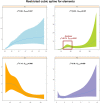Assessing the Association of Element Imbalances With Arsenism and the Potential Application Value of Rosa roxburghii Tratt Juice
- PMID: 35548358
- PMCID: PMC9082068
- DOI: 10.3389/fphar.2022.819472
Assessing the Association of Element Imbalances With Arsenism and the Potential Application Value of Rosa roxburghii Tratt Juice
Abstract
Endemic arsenism caused by coal burning is a unique type of biogeochemical disease that only exists in China, and it is also a disease of element imbalances. Previous studies have shown that element imbalances are involved in the pathogenesis of arsenic; however, the interaction between the various elements and effective preventive measures have not been fully studied. This study first conducted a cross-sectional study of a total of 365 participants. The results showed that arsenic exposure can increase the content of elements (Al, As, Fe, Hg, K, and Na) in the hair (p < 0.05), but the content of other elements (Ca, Co, Cu, Mn, Mo, P, Se, Sr, V, and Zn) was significantly decreased (p < 0.05). Also, the high level of As, Fe, and Pb and the low level of Se can increase the risk of arsenism (p < 0.05). Further study found that the combined exposure of Fe-As and Pb-As can increase the risk of arsenism, but the combined exposure of Se-As can reduce the risk of arsenism (p < 0.05). In particular, a randomized, controlled, double-blind intervention study reveals that Rosa roxburghii Tratt juice (RRT) can reverse the abovementioned element imbalances (the high level of Al, As, and Fe and the low level of Cu, Mn, Se, Sr, and Zn) caused by arsenic (p < 0.05). Our study provides some limited evidence that the element imbalances (the high level of As, Fe, and Pb and the low level of Se) are the risk factors for the occurrences of arsenism. The second major finding was that RRT can regulate the element imbalances, which is expected to improve arsenism. This study provides a scientific basis for further understanding a possible traditional Chinese health food, RRT, as a more effective detoxication of arsenism.
Keywords: Rosa roxburghii Tratt; arsenism; cross-sectional study; element imbalance; intervention study.
Copyright © 2022 Xu, Sun, Zeng, Wei, Yang and Zhang.
Conflict of interest statement
The authors declare that the research was conducted in the absence of any commercial or financial relationships that could be construed as a potential conflict of interest.
Figures






Similar articles
-
[Regulating effects of Rosa roxburghii tratt preparation on immune function in arseniasis patients caused by coal burning].Zhonghua Yu Fang Yi Xue Za Zhi. 2013 Sep;47(9):783-7. Zhonghua Yu Fang Yi Xue Za Zhi. 2013. PMID: 24351556 Clinical Trial. Chinese.
-
Assessing the potential value of Rosa Roxburghii Tratt in arsenic-induced liver damage based on elemental imbalance and oxidative damage.Environ Geochem Health. 2021 Mar;43(3):1165-1175. doi: 10.1007/s10653-020-00612-4. Epub 2020 Jun 20. Environ Geochem Health. 2021. PMID: 32564172
-
[Study on distribution of endemic arsenism in China].Wei Sheng Yan Jiu. 2003 Nov;32(6):519-40. Wei Sheng Yan Jiu. 2003. PMID: 14963897 Chinese.
-
An overview on chronic arsenism via drinking water in PR China.Toxicology. 2004 May 20;198(1-3):25-9. doi: 10.1016/j.tox.2004.01.016. Toxicology. 2004. PMID: 15138026 Review.
-
Progress in ICP-MS Analysis of Minerals and Heavy Metals in Traditional Medicine.Front Pharmacol. 2022 Jun 28;13:891273. doi: 10.3389/fphar.2022.891273. eCollection 2022. Front Pharmacol. 2022. PMID: 35837276 Free PMC article. Review.
Cited by
-
Rosa roxburghii Tratt juice ameliorates metabolic disorder in arsenicosis patients based on the analysis of untargeted plasma metabolomics.Front Pharmacol. 2025 Apr 22;16:1488113. doi: 10.3389/fphar.2025.1488113. eCollection 2025. Front Pharmacol. 2025. PMID: 40331187 Free PMC article.
-
Effects of arsenic exposure on blood trace element levels in rats and sex differences.Biometals. 2024 Oct;37(5):1099-1111. doi: 10.1007/s10534-024-00594-1. Epub 2024 Apr 3. Biometals. 2024. PMID: 38568319
References
-
- Alarcón-Herrera M. T., Bundschuh J., Nath B., Nicolli H. B., Gutierrez M., Reyes-Gomez V. M., et al. (2013). Co-occurrence of Arsenic and Fluoride in Groundwater of Semi-arid Regions in Latin America: Genesis, Mobility and Remediation. J. Hazard. Mater. 262, 960–969. 10.1016/j.jhazmat.2012.08.005 - DOI - PubMed
-
- An H. J., Kim I. T., Park H. J., Kim H. M., Choi J. H., Lee K. T. (2011). Tormentic Acid, a Triterpenoid Saponin, Isolated from Rosa Rugosa, Inhibited LPS-Induced iNOS, COX-2, and TNF-α Expression through Inactivation of the Nuclear Factor-Κb Pathway in RAW 264.7 Macrophages. Int. Immunopharmacol 11, 504–510. 10.1016/j.intimp.2011.01.002 - DOI - PubMed
LinkOut - more resources
Full Text Sources
Research Materials

